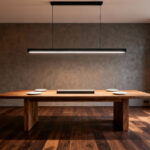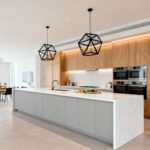Let’s be honest. For many of us, the “living room” has become the “everything room.” It’s the office, the video conference backdrop, the kids’ study hall, and—if you’re lucky—still a place to relax at the end of the day. As someone who has spent years designing corporate offices and then helping people transition to remote work, I’ve seen firsthand how a poorly designed space can drain your energy and kill your focus. The goal isn’t just to make your living room look good; it’s to make it work for you.
Modern design isn’t about cold, empty spaces anymore. Thank goodness. It’s about smart, intentional choices that create a sense of calm and order, which directly impacts your well-being and productivity. You can have a room that’s stylish enough for guests but functional enough for your 9-to-5.
Think of this as a practical guide. These aren’t just abstract design “rules.” They are strategies I use with my clients to create spaces that support their professional goals without sacrificing personal comfort. We’ll cover everything from furniture that does double duty to lighting that makes you look great on camera.
1. Start with a Minimalist Mindset for Mental Clarity
The word “minimalism” makes a lot of people nervous. They picture a white, empty box with one very uncomfortable-looking chair. But that’s not what I’m talking about. A minimalist foundation is really about decluttering your visual field so your brain can actually relax. When you aren’t subconsciously cataloging every little knick-knack on a shelf, you have more mental energy for the tasks that matter.

I worked with a freelance writer who felt constantly overwhelmed in his apartment. We didn’t throw everything out. Instead, we did a “visual audit.” Does this item serve a function? Does it bring you genuine joy? Anything that didn’t meet that criteria was either stored or donated. The effect was immediate. He said it was like turning down the static in his brain. You can start by clearing just one surface—your coffee table, for example. The sense of calm it creates is addictive. This isn’t about emptiness; it’s about creating breathing room.
This is your starting block. Once you have this calm foundation, every other decision we make will be more impactful.
2. Master a Neutral Palette (It’s Not Boring, I Promise)
Neutral palettes get a bad rap for being bland, but they are the secret weapon of sophisticated, flexible design. Think of colors like soft grays, warm whites, and rich taupes as the perfect canvas. They reflect light beautifully, which can make a small room feel much bigger and brighter—a huge plus when you’re stuck inside all day. What’s really interesting is how a neutral’s undertone (cool or warm) can completely change with the light, giving your room a different mood from morning to night.

The real skill here is in layering. A room with just one shade of beige is, frankly, boring. But a room with cool gray walls, a warmer greige sofa, creamy linen curtains, and a pop of charcoal in a pillow? That has depth and character. The 60-30-10 rule is a great starting point: 60% dominant neutral (like your walls), 30% secondary neutral (like your sofa), and 10% for your accents. Those accents—a touch of black metal, a rich wood tone, a splash of color—are where your personality shines through.
A solid neutral base gives you the freedom to change up your style with small, inexpensive updates rather than a complete overhaul.
3. Go Low-Profile with Furniture to Open Things Up
Here’s a trick that designers use constantly: low-profile furniture. Sofas with low backs, coffee tables that sit closer to the ground, and sleek media consoles create an uninterrupted sightline across the room. Your eye keeps moving, which tricks your brain into perceiving the space as larger and more open. This is a game-changer, especially in smaller apartments or homes with lower ceilings.

It’s not just about visual space; it’s about a feeling of ease. When your furniture isn’t towering over you, the room feels less crowded and more restful. I’m a huge fan of platform sofas and media units that appear to float on the wall. They leave negative space above and below, which allows your walls, windows, and art to breathe. What you don’t fill is just as important as what you do fill.
This single choice can make a cramped room feel surprisingly airy and luxurious.
4. Choose Multi-Functional Pieces for Smarter Living
Multi-functional furniture isn’t just for dorm rooms anymore. The design has become so clever and stylish that you’d never guess these pieces are working twice as hard. A beautiful storage ottoman is my go-to recommendation. It’s a footrest, extra seating for guests, and the perfect spot to hide away blankets, laptops, and kid toys at the end of the day.

This is where my corporate and home office worlds really collide. We need spaces that can transform quickly. One minute, your living room is your office; the next, it needs to be ready for movie night. A coffee table that lifts to become a comfortable work surface or nesting tables that can be spread out for company and then tucked away are brilliant. It’s about buying fewer, better things that adapt to your life. Frankly, it’s a more sustainable and budget-friendly approach in the long run.
Your goal is to find pieces that hide their utility so well they just look like great design.
5. Plan Your Furniture Layout for Effortless Flow
Ever walked into a room and it just felt…awkward? Chances are, the traffic flow was off. Before you place a single piece of furniture, think about the natural paths people take through the room. Where are the doorways? How do you get from the sofa to the kitchen? Block these main arteries and the room will always feel clumsy. The professional standard is to leave about 36 inches for major walkways.

Once you’ve established your paths, you can “float” your furniture away from the walls. I know it sounds counterintuitive, especially in a smaller space, but pushing a sofa against a wall can actually make a room feel more boxed-in. Creating a seating group in the middle of the room with paths around it often makes the space feel larger and more intentional. For conversation areas, a distance of 4 to 8 feet between seats is ideal—close enough to talk without shouting, but far enough for personal space.
This invisible framework is what makes a room feel intuitive and easy to live in.
6. Define Zones in Open-Concept Spaces
Open-concept living is great, but it can also feel like one big, undefined warehouse if you’re not careful. The key is to create “zones” for different activities without putting up walls. This is where furniture and rugs become your best friends. A large area rug, for instance, is the single best tool for this. It can visually anchor your living room furniture, clearly defining it as a distinct zone separate from the dining area or a workspace.

I often use the back of a sofa as a soft “wall” to delineate the conversation area from a walkway or a nearby dining table. A tall, open-backed bookshelf can also create a subtle separation, offering a sense of privacy for a small desk area without blocking light or sightlines. You’re essentially using objects to create rooms within a room. This approach makes a large, open space feel cozier, more organized, and infinitely more functional.
You’ll find the space just “makes sense” when each area has a clear purpose.
7. Layer Your Lighting for Mood and Function
Lighting is everything. Seriously. It’s the most overlooked but most powerful tool in design. A single, harsh overhead light makes a room feel flat and institutional. Instead, you need to think in layers: Ambient, Task, and Accent.

- Ambient: This is your general, overall light. It can be from recessed ceiling lights, a stylish chandelier, or track lighting. This is the foundation that lets you see and move around safely.
- Task: This is focused light for specific activities. A floor lamp next to your reading chair, an adjustable desk lamp for your work area, or under-cabinet lighting in a built-in. As an ergonomics specialist, I can tell you that proper task lighting prevents eye strain and keeps you focused.
- Accent: This is the fun layer! It’s for highlighting things you love, like a piece of art, a beautiful plant, or an architectural feature. Think picture lights or small uplights.
The real magic happens when you put all your lights on dimmer switches. With the press of a button, you can go from bright, energetic light for a work session to a soft, moody glow for relaxing.
8. Use a Statement Light as Functional Art
Don’t be afraid to go bold with at least one light fixture. A dramatic chandelier, an oversized arc floor lamp, or a sculptural pendant light can serve as the primary focal point of your room. It’s like a piece of art that also happens to be practical. It tells a story about your style and sets the tone for the entire space.

Scale is crucial here. A tiny fixture in a large room looks lost and silly, while a massive one can overwhelm a small space. A good rule of thumb for a chandelier’s diameter: add the room’s length and width in feet, and that’s your diameter in inches. (e.g., a 12’x15’ room = 27″, so a 27-inch diameter fixture is a great start). Remember to consider its silhouette even when it’s off—it should look just as good unlit.
This is your chance to add a “wow” factor that’s both beautiful and completely functional.
9. Bring in natural materials for Warmth
Modern design can sometimes lean a little cold and clinical. The antidote? Natural materials. Wood, stone, leather, wool, linen—these elements connect us back to the natural world and add a much-needed layer of warmth and texture. They engage our sense of touch and prevent the room from feeling sterile.

You don’t need to turn your living room into a log cabin. It’s about balance. A live-edge wood coffee table can warm up a sleek, modern sofa. Linen curtains soften the hard lines of a window. A wool or jute rug adds incredible texture underfoot. I love how these materials age and develop a patina over time; a leather chair looks even better with a bit of wear. It makes the space feel lived-in and real.
Mixing these organic elements with clean, modern lines is the key to creating a space that feels both current and timeless.
10. Layer Different Textures for a Richer Feel
A room decorated in a single texture—even with different colors—will always feel flat. Texture is what gives a space its depth and character. Think about combining different surface qualities to create a more dynamic experience. Pair a smooth leather sofa with a nubby bouclé pillow, set a glossy ceramic vase on a rough-hewn wooden shelf, or lay a soft, high-pile rug next to a sleek metal floor lamp.

A great way to approach this is to think about contrast. Hard with soft. Shiny with matte. Smooth with rough. This creates a tactile richness that makes you want to reach out and touch things. It’s particularly effective in a neutral color scheme, where texture does the heavy lifting of creating visual interest. I always tell my clients to do the “touch test”—as you design, make sure you’re incorporating a variety of surfaces that feel different.
This layering of textures is what makes a room feel curated and cozy, not just decorated.
11. Integrate Hidden Storage to Tame the Clutter
In a space that serves multiple functions, clutter is the enemy of productivity and peace. Hidden storage is the unsung hero of modern design. It’s not about having less stuff; it’s about having a smart place for everything. We’ve talked about storage ottomans, but this can also look like a sleek media console with solid doors instead of open shelves, or a lift-top coffee table with a deep compartment for your work gear.

The key is to anticipate your storage needs from the start. Where do the remotes, charging cables, and mail always end up? Designate a home for them that’s out of sight but still easily accessible. Custom built-ins are fantastic if the budget allows, but so many furniture companies—like Blu Dot or Article—are now designing beautiful pieces with this integrated storage in mind because they know how we live today.
When your daily-use items have an invisible home, your room stays looking clean and minimalist with minimal daily effort.
12. Let the Light In with Minimal Window Treatments
Natural light is a non-negotiable for well-being. It boosts our mood, helps regulate our sleep cycles, and makes any space feel better. So why would we cover our windows with heavy, bulky drapes? Modern design treats windows as architectural features to be highlighted, not hidden. The goal is to maximize daylight while still providing privacy when you need it.

My go-to solutions are simple roller shades, cellular (or honeycomb) shades, or sheer curtains. Roller and cellular shades can retract to become almost invisible, giving you a full, unobstructed view. Sheer panels are wonderful because they diffuse harsh sunlight, reduce glare on your computer screen, and offer a layer of privacy while still letting tons of light through. Mounting curtains high and wide—extending the rod well beyond the window frame—can also make your windows look larger and grander.
Your space will instantly feel brighter, bigger, and more energetic.
13. Add Plants for a Biophilic Boost
Bringing plants into your living room is one of the easiest and most impactful things you can do. It’s not just about aesthetics; it’s about biophilia—our innate human need to connect with nature. Studies have shown that having plants in our environment can reduce stress and improve focus. For anyone working from home, that’s a huge win. Plus, they literally clean the air.

Choose plants that match your light conditions and your level of commitment. A Fiddle Leaf Fig is dramatic but notoriously fussy. A Snake Plant or a ZZ Plant, on the other hand, are nearly indestructible and thrive on neglect. Think about placement: a large floor plant can anchor a corner and add vertical height, while a trailing Pothos on a high shelf adds a lovely, cascading effect. And don’t forget the planters! A beautiful ceramic or concrete pot is a decorative object in its own right.
Plants add life, color, and dynamic energy to a room in a way no inanimate object can.
14. Anchor Your Seating with the Right-Sized Rug
This is probably the single most common design mistake I see: the rug that’s too small. A little “postage stamp” rug floating in the middle of the floor with all the furniture huddled around it just looks wrong. It makes the whole room feel disconnected and out of proportion. A rug’s job is to unify a seating area and create a defined, cohesive zone.

The rule is simple: at least the front legs of all your main seating pieces (sofa, chairs) should be sitting on the rug. All the legs on the rug is even better if you have the space. For a typical living room, you’re likely looking at an 8’x10’ or 9’x12’ rug. It might seem like a big investment, but it’s the foundation of the room. It also adds a huge amount of warmth, texture, and sound absorption—which is great for reducing echo on video calls.
Get the rug right, and the rest of the room will fall into place around it.
15. Curate Art and Decor That Means Something
Your art and decor are where your personality really gets to come out and play. This isn’t about buying generic “wall art” from a big-box store to fill a space. It’s about curating a collection of pieces that you genuinely love and that tell your story. It could be a painting from a local artist, a beautiful photograph you took on vacation, or a sculptural object you found at a flea market.

Quality over quantity is the mantra here. One or two meaningful pieces will have far more impact than a wall cluttered with a dozen small, insignificant items. When you place art, give it breathing room. Don’t crowd it with other things. Let it be a focal point. A gallery wall can be great, but it needs to feel cohesive, tied together by a common theme, color palette, or frame style.
This is what transforms a “designed” room into your home.
16. Use a Bold Abstract Painting as a Focal Point
If you want to make a confident statement, nothing does it better than a large, bold piece of abstract art. It instantly injects energy and personality into a room and can act as the anchor for your entire color scheme. It’s often less about the subject matter and more about the color, movement, and scale.

Don’t be timid with size. A large painting can actually make a room feel bigger by creating a clear and dramatic focal point, simplifying the visual landscape. As a general guide, the artwork should take up about two-thirds of the wall space above the piece of furniture it’s hanging over (like a sofa). And hang it at the right height! The center of the piece should be at eye level, which is typically 57-60 inches from the floor. You can then pull two or three accent colors from the artwork to use for your pillows, throws, and other accessories.
It’s a powerful move that creates a cohesive, designer look with one great decision.
17. Sprinkle in Strategic Pops of Color
While your foundation may be neutral, a modern room still needs a little bit of life. Strategic pops of color provide that energy and keep the space from feeling one-note. The key word here is “strategic.” We’re not talking about a 1980s-style rainbow explosion. We’re talking about using that “10%” of your 60-30-10 color rule.

Choose one or two accent colors you love and sprinkle them throughout the room in small doses. Maybe it’s a couple of terracotta pillows on the sofa, a similar-hued vase on the bookshelf, and a touch of that same color in your artwork. Repeating the accent color in a few places makes it feel intentional and helps your eye move around the room. The best part? These are usually inexpensive, easy-to-change items like textiles and accessories, so you can swap them out seasonally or whenever you want a fresh look.
This is the final layer that adds vibrancy and personality without overwhelming the calm you’ve worked to create.
18. Integrate Smart Tech Without the Clutter
Smart technology can make our lives so much easier, but it can also create a new kind of clutter: a mess of wires, gadgets, and hubs. The goal of a truly modern home is to integrate this tech seamlessly, so it enhances your life without compromising your aesthetic.

Think invisible convenience. Instead of a smart speaker sitting on every surface, consider in-wall or in-ceiling speakers. Swap out your light switches for smart dimmer switches that look clean and minimal. Use smart plugs (from brands like Kasa or TP-Link) to control lamps and other devices without having to see the tech itself. The goal is an environment that responds to you—via voice, an app, or automated schedules—while the technology behind it stays completely hidden.
A well-designed smart home should feel like magic, not a computer lab.
19. Look Up: Use Your Vertical Space
In any room, but especially smaller ones, don’t forget to use your walls. Utilizing vertical space draws the eye upward, creating an illusion of height, while also freeing up precious floor space. This is a game-changer for storage and display.

Floating shelves are a classic modern choice for books and curated objects. Wall-mounted media consoles clear the floor entirely, making the room feel lighter and easier to clean. I’m also a big fan of tall, narrow bookcases, like the CB2 “Stairway” line, that have a small footprint but offer tons of storage. They add an architectural element to the room while being incredibly practical.
Getting things up off the floor is one of the quickest ways to reduce visual clutter and make your space feel bigger.
20. Prioritize Comfort with Ergonomic Choices
A beautiful living room that’s uncomfortable to sit in is a failure. Period. As an ergonomics specialist, I see this all the time—people buying a sofa based purely on its sleek, modern lines, only to find it’s miserable to sit on for more than 10 minutes. Your living room needs to be a place of genuine rest and comfort.

This doesn’t mean you have to buy a big, puffy recliner. You can find stylish furniture with good ergonomic support. When you’re testing a sofa or chair, pay attention: does the seat depth allow you to sit back with your feet on the floor? Is there good lumbar support for your lower back? Are the armrests at a comfortable height? The quality of the cushions matters, too. High-density foam will provide support and hold its shape far longer than cheap fill.
Your body will thank you for choosing furniture that balances form with genuine, everyday comfort.
21. Create a Cohesive Vibe in an Open-Concept Layout
If you have an open-concept living, dining, and kitchen area, creating a sense of harmony is essential. You want the spaces to feel connected and part of a whole, even while they serve different functions. Repetition is the key to achieving this.

Establish a master plan for the entire open area. Use the same flooring throughout to create a seamless flow. Stick to your chosen 60-30-10 color palette across all zones, even if you use the colors in different proportions in each area. Repeat materials and finishes—if you have black metal accents in your living room lighting, carry that into your dining chair legs or kitchen hardware. This consistent thread of color, material, and style will tie everything together, making the entire space feel cohesive, intentional, and much larger.
It’s All About Creating a Space That Serves You
Building a modern living room that doubles as a workspace and a sanctuary isn’t about checking off a list of trends. It’s about a series of thoughtful choices that, together, create an environment that supports your real life. When your space is uncluttered, well-lit, and comfortable, you’re more focused, more relaxed, and more productive. It proves that good design is an investment in your well-being.
The most successful spaces feel effortless, but they are born from careful planning. Start small. Pick one thing from this list—maybe it’s getting the right-sized rug or finally tackling that cable mess. Each small improvement builds on the last.
Remember, the goal is a room that works just as hard as you do, and still feels like home when the workday is done. You can do this.






